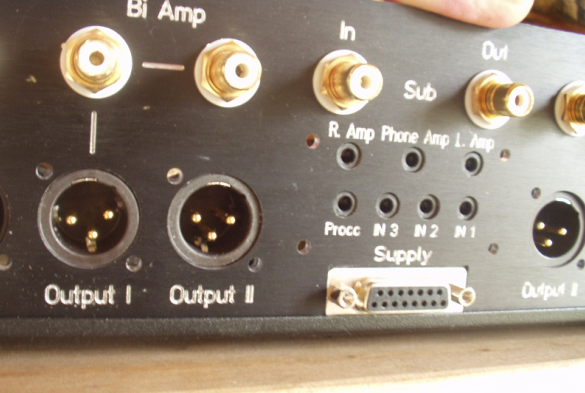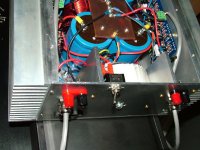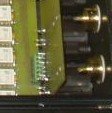GRollins said:EDIT: Waitaminnit...if they're French, why's all the nomenclature in English?
Because it's "chic"
Just the cultural opposite of a "Meniou" written in French in a french restaurant in GB or US.
And more casually 1) the french ornaments "éùàçèï" were not available from the font used by the machine shop & 2) English is handier than French in putting less words - and less letters - to write the same thing. And the space was tight
Hmmm...never thought of English as the lingua franca of audio. Obviously I'm immersed in English here in the US, but I try to remain aware that it isn't so for others. (In fact, I used to translate measurements into metric in my posts, but no one seemed to care so I gave it up. Wish the US would go metric, but I doubt it will happen during my life.) Yet in this one, admittedly limited, case it appears that English has made it to France. Interesting.
Don't blame me for McDonalds. I never eat there.
All my bottles of Bordeaux are in French. Wouldn't have it any other way. Interestingly, the vast majority of my Italian wines are printed in English. Why that should be so, I'm not sure.
My Australian wines are in some gawd-awful lingo that's nearly impenetrable to them what speaks proper English. (Smile, guys, I'm kidding you.)
Grey
Don't blame me for McDonalds. I never eat there.
All my bottles of Bordeaux are in French. Wouldn't have it any other way. Interestingly, the vast majority of my Italian wines are printed in English. Why that should be so, I'm not sure.
My Australian wines are in some gawd-awful lingo that's nearly impenetrable to them what speaks proper English. (Smile, guys, I'm kidding you.)
Grey
Actually, part of my interest is of a practical intent. Late this summer I intend to do battle with a local machine shop and finally have them make decent a chassis or two. I've had some really bad experiences in the past, and have generally put up with throw-together informal boxes since then.
I'm just glad I don't have to worry about this stuff for a living, as I'd go nuts trying to get good metal work done locally.
Grey
I'm just glad I don't have to worry about this stuff for a living, as I'd go nuts trying to get good metal work done locally.
Grey
Hey Grey,
As usual, Cheffs nail is down.
The use of english in France is mostly a matter of economical pragmatism and prestige ("chic"). Latter includes the magic coming from something you don't really understand. And for a given thing, only changing the name will make people happy to pay more for it : If you cannot pay somebody simply give him a medal instead.
Usually individual words don't pose so much problems for french people to understand as (little kidding) the most english words are of french origin.
A little game if I may,
in this list only one word does not come from french :
Tennis
challenge
match
toast
flirt
cash
foreign
computer
rosbif
porridge
etc...
which one ?
darn, O, Jeanne d'Arc if there had not been you, tody, we would all speak... French.
But seriously. Words are not the langage. Putting words together to make sentences, phrases and texts is an other story.
I found for myself that admiration is always (one of) the best motivation to learn something.
So I would say our (we dyier français) attempt to use english words are much more the fact that we feel very good paying a tribute to nelsons genius and style.
Manuel
As usual, Cheffs nail is down.
The use of english in France is mostly a matter of economical pragmatism and prestige ("chic"). Latter includes the magic coming from something you don't really understand. And for a given thing, only changing the name will make people happy to pay more for it : If you cannot pay somebody simply give him a medal instead.
Usually individual words don't pose so much problems for french people to understand as (little kidding) the most english words are of french origin.
A little game if I may,
in this list only one word does not come from french :
Tennis
challenge
match
toast
flirt
cash
foreign
computer
rosbif
porridge
etc...
which one ?
darn, O, Jeanne d'Arc if there had not been you, tody, we would all speak... French.
But seriously. Words are not the langage. Putting words together to make sentences, phrases and texts is an other story.
I found for myself that admiration is always (one of) the best motivation to learn something.
So I would say our (we dyier français) attempt to use english words are much more the fact that we feel very good paying a tribute to nelsons genius and style.
Manuel
OK, I'm back...
Haven't had a lot of time since my trip to work on the circuit, but I have been able to do some more extended listening. I noticed some mild listening fatigue after longer listenings, which I quickly traced to a very broad, shallow peak across the entire the midbass / lower midrange - roughly 1dB spanning 30Hz - nearly 1kHz. This isn't the fault of the circuit, but rather the HD600's, which don't present a very flat impedance to the amp. The peak was exacerbated by driving both ears in parallel on a single channel of the amp. Some 50 Ohm 'damping' resistors across the transformer secondary lowered the output Z, and dropped the peak down to around 0.3dB without too much loss in SPL. Even 100R resistors held the peak to <0.5dB. I found this to be a significant improvement, effectively eliminating the fatigue. The overall subjective impression did not change much, although more of the relaxed character of the HD600's did start to return at the lower impedances - in some ways I preferred the slightly livelier presentation with the 100R resistors. I'll re-evaluate once I've got a stereo pair going, but my measurements so far are looking just fine with the CUGS driving only a single ear, even without damping R's.
I also took some time to create a small spreadsheet, calculating the max power / SPL drive limit of my setup (CUGS through 2:1 output transformer) into various headphones - from high-Z ones like AKG & Sennheiser, through low-Z phones like Grados. I'd only done a quick back-of-envelope calculation before, so this basically just serves to confirm what I already knew, but wanted to be sure of - the CUGS as I've designed it will drive pretty much any headphone right up to or in many cases beyond it's max rated spec. Adding 100R or 50R damping resistors in parallel with the output can be used to decrease the output Z for phones which demand it, at a modest sacrifice in ultimate SPL.
The spreadsheet might be useful to anyone who wants to calculate power requirements for driving their headphones (using any amp) - in my case, I've assumed the output is always current limited, and then created a Thevenized source to represent the CUGS's power delivery at the threshold of clipping. It should be noted that the Thevenized power source equivalent impedance / voltage levels (cells B14 - B19) used for the max power calculations do not represent the actual output impedance and voltage of the circuit. The actual circuit output impedances with and without 'damping' resistors are shown above. That said, for other circuits (typically voltage-limited), the Thevenin values can be populated with the maximum output voltage and the actual output impedance of the amp. Check out Rane app note 100 "Understanding Headphone Power Requirements" for more info on driving headphones, and a nice little table listing the Z and sensitivity of many common phones.
I also measured the (differential) output impedance, which is just shy of 100Ohms, at 98.5. On the secondary side of the CMOQ-3H tranny, wired for 2:1 step-down, the output Z is about 46Ohms, just inside of what I consider to be the limit of acceptable for a line driver / preamp / headphone driver. In general I try to aim for 10 Ohms or less.
I won't have much more time to spend on this until the weekend, but at this point I'm debating whether I'll spend the time to build a second channel point-to-point, or if I should just press ahead with a PCB layout instead.
Oh, one other point to make before I sign off for the night, I have not found the 5pF caps in the feedback network to be necessary yet. With a 2:1 trannie on the output, I doubt I'll need them, but they may still be a good idea for additional stability if the outputs are DC coupled for line-driving duty. My simulations showed a mild peak out at a few MHz without them, but I have not observed any ringing on the scope so far. Unless I see a problem, I'm going to leave them off, but the PCB layout will have a spot for them, just in case.
Haven't had a lot of time since my trip to work on the circuit, but I have been able to do some more extended listening. I noticed some mild listening fatigue after longer listenings, which I quickly traced to a very broad, shallow peak across the entire the midbass / lower midrange - roughly 1dB spanning 30Hz - nearly 1kHz. This isn't the fault of the circuit, but rather the HD600's, which don't present a very flat impedance to the amp. The peak was exacerbated by driving both ears in parallel on a single channel of the amp. Some 50 Ohm 'damping' resistors across the transformer secondary lowered the output Z, and dropped the peak down to around 0.3dB without too much loss in SPL. Even 100R resistors held the peak to <0.5dB. I found this to be a significant improvement, effectively eliminating the fatigue. The overall subjective impression did not change much, although more of the relaxed character of the HD600's did start to return at the lower impedances - in some ways I preferred the slightly livelier presentation with the 100R resistors. I'll re-evaluate once I've got a stereo pair going, but my measurements so far are looking just fine with the CUGS driving only a single ear, even without damping R's.
I also took some time to create a small spreadsheet, calculating the max power / SPL drive limit of my setup (CUGS through 2:1 output transformer) into various headphones - from high-Z ones like AKG & Sennheiser, through low-Z phones like Grados. I'd only done a quick back-of-envelope calculation before, so this basically just serves to confirm what I already knew, but wanted to be sure of - the CUGS as I've designed it will drive pretty much any headphone right up to or in many cases beyond it's max rated spec. Adding 100R or 50R damping resistors in parallel with the output can be used to decrease the output Z for phones which demand it, at a modest sacrifice in ultimate SPL.
The spreadsheet might be useful to anyone who wants to calculate power requirements for driving their headphones (using any amp) - in my case, I've assumed the output is always current limited, and then created a Thevenized source to represent the CUGS's power delivery at the threshold of clipping. It should be noted that the Thevenized power source equivalent impedance / voltage levels (cells B14 - B19) used for the max power calculations do not represent the actual output impedance and voltage of the circuit. The actual circuit output impedances with and without 'damping' resistors are shown above. That said, for other circuits (typically voltage-limited), the Thevenin values can be populated with the maximum output voltage and the actual output impedance of the amp. Check out Rane app note 100 "Understanding Headphone Power Requirements" for more info on driving headphones, and a nice little table listing the Z and sensitivity of many common phones.
I also measured the (differential) output impedance, which is just shy of 100Ohms, at 98.5. On the secondary side of the CMOQ-3H tranny, wired for 2:1 step-down, the output Z is about 46Ohms, just inside of what I consider to be the limit of acceptable for a line driver / preamp / headphone driver. In general I try to aim for 10 Ohms or less.
I won't have much more time to spend on this until the weekend, but at this point I'm debating whether I'll spend the time to build a second channel point-to-point, or if I should just press ahead with a PCB layout instead.
Oh, one other point to make before I sign off for the night, I have not found the 5pF caps in the feedback network to be necessary yet. With a 2:1 trannie on the output, I doubt I'll need them, but they may still be a good idea for additional stability if the outputs are DC coupled for line-driving duty. My simulations showed a mild peak out at a few MHz without them, but I have not observed any ringing on the scope so far. Unless I see a problem, I'm going to leave them off, but the PCB layout will have a spot for them, just in case.
Attachments
hi there,
some of us have continued to work on the UGS "atours" as we say in French !
For menu :
- 4 inputs unbalanced and balanced
- 2 outputs (un and balanced)
- 4 triggers IN
- 3 triggers OUT
- volume control attenuator 128 steps of 0.75dB by relays
- sources selection by relays also (TQ2-24V)
- LCD display 2x20 characters
- IR remote control (not yet defined for me !!!)
- subwoofer module !
- bypass to use your amplifiers for HT (for example !) without using the UGS part
- etc.....
So, it's a jewel that Cheff has thought !
Thanks a lot to him !
Just a picture to show you !!!!
some of us have continued to work on the UGS "atours" as we say in French !
For menu :
- 4 inputs unbalanced and balanced
- 2 outputs (un and balanced)
- 4 triggers IN
- 3 triggers OUT
- volume control attenuator 128 steps of 0.75dB by relays
- sources selection by relays also (TQ2-24V)
- LCD display 2x20 characters
- IR remote control (not yet defined for me !!!)
- subwoofer module !
- bypass to use your amplifiers for HT (for example !) without using the UGS part
- etc.....
So, it's a jewel that Cheff has thought !
Thanks a lot to him !
Just a picture to show you !!!!
An externally hosted image should be here but it was not working when we last tested it.
but- I personally don't like any sort of connectors seen on these pics;
how about these connectors????
Attachments
jupiterjune said:
how about these connectors????
nice connectors , but dreky pcbs .

The connectors you don't like (I think you talk about the flat cables?) are for le µC board, plus the relays command lines. No audio signal is leaving the main boards.Zen Mod said:Ugly!
but- I personally don't like any sort of connectors seen on these pics;
good for DC supplies,but for sig...........in DIY...........naah.
Maousse said:No audio signal is leaving the main boards.
Could have fooled me.
Attachments
Not trying to fool, just talking about the flat cables.jacco vermeulen said:Could have fooled me.
But you are right, at that place, there can be some hard wires soldered instead of connectors.
I'll test, but not sure my system allows me to hear something.
jacco vermeulen said:
Could have fooled me.
but.........as I said......... clever,but we are here usually to split hairs.....in good mood ........
Arf 
Counting angels on a pinhead ?
These are gold plated connectors, with max contact resistance of 12 milliohms/contact, and are //ed two by two, so 6 milliohms/signal line max.
OK, I do not have figures about capacitance and inductance, so the reason of dislike must be there
Counting angels on a pinhead ?
These are gold plated connectors, with max contact resistance of 12 milliohms/contact, and are //ed two by two, so 6 milliohms/signal line max.
OK, I do not have figures about capacitance and inductance, so the reason of dislike must be there
- Home
- Amplifiers
- Pass Labs
- UGS adventures



